Chelsea F.C.
From Wikipedia, the free encyclopedia
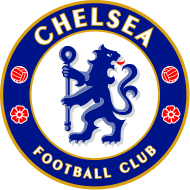 |
||||
| Full name | Chelsea Football Club | |||
|---|---|---|---|---|
| Nickname(s) | The Blues | |||
| Founded | 10 March 1905[1] | |||
| Ground | Stamford Bridge, Fulham, London (capacity: 41,837[2]) |
|||
| Owner | Roman Abramovich | |||
| Chairman | Bruce Buck | |||
| Manager | Roberto Di Matteo | |||
| League | Premier League | |||
| 2011–12 | Premier League, 6th | |||
| Website | Club home page | |||
|
||||
Chelsea had their first major success in 1955, when they won the league championship, and won various cup competitions during the 1960s, 1970s, 1990s and 2000s. Since 1996, Chelsea have enjoyed the most successful period in their history. Overall, Chelsea have won four league titles, seven FA Cups, four League Cups and four FA Community Shields. The club have also been successful in continental competitions, winning two UEFA Cup Winners' Cups, one UEFA Super Cup and one UEFA Champions League title. In 2009–10, the club won their first "Double"[3] and in 2012 became the first London club to win the UEFA Champions League.[4][5]
Chelsea's regular kit colours are royal blue shirts and shorts with white socks. The club's crest has been changed several times in attempts to re-brand the club and modernise its image. The current crest, featuring a ceremonial lion rampant regardant holding a staff, is a modification of the one introduced in the early 1950s.[6] The club has sustained the fifth highest average all-time attendance in English football.[7] Their average home gate for the 2011–12 season was 41,478, the sixth highest in the Premier League.[8] In April 2012 it was ranked by Forbes Magazine as the seventh most valuable football club in the world, at £473 million ($761 million).[9][10] Since 2003, Chelsea have been owned by Russian billionaire Roman Abramovich.[11]
Contents |
History
Main article: History of Chelsea F.C.
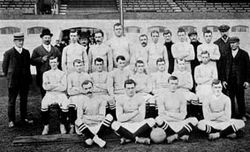
The first Chelsea team in September 1905
The club won promotion to the First Division in their second season, and yo-yoed between the First and Second Divisions in their early years. They reached the 1915 FA Cup Final, where they lost to Sheffield United at Old Trafford, and finished 3rd in the First Division in 1920, the club's best league campaign to that point.[13] Chelsea attracted large crowds[14] and had a reputation for signing big-name players,[15] but success continued to elude the club in the inter-war years. Former Arsenal and England centre-forward Ted Drake became manager in 1952 and proceeded to modernise the club. He removed the club's Chelsea pensioner crest, improved the youth set-up and training regime, rebuilt the side with shrewd signings from the lower divisions and amateur leagues, and led Chelsea to their first major trophy success – the League championship – in 1954–55. The following season saw UEFA create the European Champions' Cup, but after objections from The Football League and the FA Chelsea were persuaded to withdraw from the competition before it started.[16] Chelsea failed to build on this success, and spent the remainder of the 1950s in mid-table. Drake was dismissed in 1961 and replaced by player-coach Tommy Docherty.

Chart showing the progress of Chelsea's league finishes from 1905–1906 season to 2007–08 season
The late 1970s through to the 1980s was a turbulent period for Chelsea. An ambitious redevelopment of Stamford Bridge threatened the financial stability of the club,[18] star players were sold and the team were relegated. Further problems were caused by a notorious hooligan element among the support, which was to plague the club throughout the decade.[19] In 1982, Chelsea were, at the nadir of their fortunes, acquired by Ken Bates for the nominal sum of £1, although by now the Stamford Bridge freehold had been sold to property developers, meaning the club faced losing their home.[20] On the pitch, the team had fared little better, coming close to relegation to the Third Division for the first time, but in 1983 manager John Neal put together an impressive new team for minimal outlay. Chelsea won the Second Division title in 1983–84 and established themselves in the top division, before being relegated again in 1988. The club bounced back immediately by winning the Second Division championship in 1988–89.

Chelsea players celebrate their first UEFA Champions League title
In June 2003, Bates sold Chelsea to Russian billionaire Roman Abramovich for £140 million.[11] Over £100 million was spent on new players, but Ranieri was unable to deliver any trophies,[22] and was replaced by José Mourinho.[23] Under Mourinho, Chelsea became the fifth English team to win back-to-back league championships since the Second World War (2004–05 and 2005–06),[24] in addition to winning an FA Cup (2007) and two League Cups (2005 and 2007). In September 2007, Mourinho was replaced by Avram Grant,[25] who led the club to their first UEFA Champions League final, which they lost on penalties to Manchester United. In 2009, caretaker manager Guus Hiddink guided Chelsea to another FA Cup success,[26] and in 2009–10, his successor Carlo Ancelotti led them to their first league and FA Cup "Double", becoming the first English club to score 100 league goals in a season since 1963.[27] In June 2011, Ancelotti was sacked and replaced by André Villas-Boas,[28] who was in turn dismissed in March 2012. Under caretaker manager Roberto Di Matteo, Chelsea won their seventh FA Cup,[29] and their first UEFA Champions League title, beating Bayern Munich 4–3 on penalties,[30] the first London club to win the trophy.[30]
Stadium
Main article: Stamford Bridge (stadium)
| Stamford Bridge | |
|---|---|
| The Bridge | |
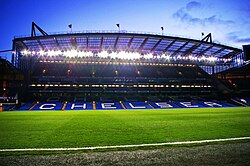 |
|
| Location | Fulham Road, Fulham London, England, SW6 1HS |
| Opened | 28 April 1877[31] |
| Renovated | 1904–1905, 1990s |
| Owner | Chelsea Pitch Owners plc |
| Operator | Chelsea F.C. |
| Architect | Archibald Leitch (1887) |
| Capacity | 41,837-seat[2] |
| Field dimensions | 103 x 67 metres (112.6 x 73.3 yards)[2] |
| Tenants | |
| London Athletics Club (1877–1904) Chelsea F.C. (1905–present) |
|
Starting with an open bowl-like design and one covered terrace, Stamford Bridge had an original capacity of around 100,000.[31] The early 1930s saw the construction of a terrace on the southern part of the ground with a roof that covered around one fifth of the stand. It eventually became known as the "Shed End", the home of Chelsea's most loyal and vocal supporters, particularly during the 1960s, 70s and 80s. The exact origins of the name are unclear, but the fact that the roof looked like a corrugated iron shed roof played a part.[31]
In the early 1970s the club's owners announced a modernisation of Stamford Bridge with plans for a state-of-the-art 50,000 all-seater stadium.[31] Work began on the East Stand in 1972 but the project was beset with problems and was never completed; the cost brought the club close to bankruptcy, culminating in the freehold being sold to property developers. Following a long legal battle, it was not until the mid-1990s that Chelsea's future at the stadium was secured and renovation work resumed.[31] The north, west and southern parts of the ground were converted into all-seater stands and moved closer to the pitch, a process completed by 2001.
When Stamford Bridge was redeveloped in the Ken Bates era many additional features were added to the complex including two hotels, apartments, bars, restaurants, the Chelsea Megastore, and an interactive visitor attraction called Chelsea World of Sport. The intention was that these facilities would provide extra revenue to support the football side of the business, but they were less successful than hoped and before the Abramovich takeover in 2003 the debt taken on to finance them was a major burden on the club. Soon after the takeover a decision was taken to drop the "Chelsea Village" brand and refocus on Chelsea as a football club. However, the stadium is sometimes still referred to as part of "Chelsea Village" or "The Village".
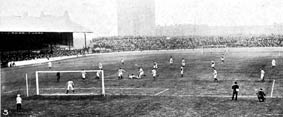
Chelsea vs. West Bromwich Albion at Stamford Bridge on 23 September 1905; Chelsea won 1–0.
Stamford Bridge has been used for a variety of other sporting events since 1905. It hosted the FA Cup Final from 1920 to 1922,[36] has held ten FA Cup semi-finals (most recently in 1978), ten FA Charity Shield matches (the last in 1970), and three England international matches, the last in 1932; it was also the venue for an unofficial Victory International in 1946.[37]
In October 1905 it hosted a rugby union match between the All Blacks and Middlesex,[38] and in 1914 hosted a baseball match between the touring New York Giants and the Chicago White Sox.[39] It was the venue for a boxing match between world flyweight champion Jimmy Wilde and Joe Conn in 1918.[40] The running track was used for dirt track racing between 1928 and 1932,[41] greyhound racing from 1933 to 1968, and Midget car racing in 1948.[42] In 1980, Stamford Bridge hosted the first international floodlit cricket match in the UK, between Essex and the West Indies.[43] It was also the home stadium of the London Monarchs American Football team for the 1997 season.[44]
The current club ownership have stated that a larger stadium is necessary in order for Chelsea to stay competitive with rival clubs who have significantly larger stadia, such as Arsenal and Manchester United.[45] Owing to its location next to a main road and two railway lines, fans can only enter the ground via the Fulham Road exits, which places constraints on expansion due to health and safety regulations.[46] The club have consistently affirmed their desire to keep Chelsea at their current home,[47][48][49] but Chelsea have nonetheless been linked with a move to various nearby sites, including the Earls Court Exhibition Centre, Battersea Power Station and the Chelsea Barracks.[50] On 3 October 2011, Chelsea made a proposal to CPO shareholders to buy back the freehold to the land on which Stamford Bridge sits, stating that "buying back the freehold removes a potential hurdle should a suitable site become available in the future".[51] The proposal was voted down by CPO shareholders.[52] In May 2012, the club made a formal bid to purchase Battersea Power Station, with a view to developing the site into a 60,000 seater stadium.[53] Chelsea released artistic impressions of the proposed stadium at the Battersea site on 22 June 2012.[54]
Crest and colours
Crest
Since the club's foundation, Chelsea have had four main crests, though all underwent minor variations. In 1905, Chelsea adopted as their first crest the image of a Chelsea pensioner, which contributed to the "pensioner" nickname, and remained for the next half-century, though it never appeared on the shirts. As part of Ted Drake's modernisation of the club from 1952 onwards, he insisted that the pensioner badge be removed from the match day programme in order to change the club's image and that a new crest be adopted.[55] As a stop-gap, a temporary emblem comprising simply the initials C.F.C. was adopted for one year. In 1953, Chelsea's crest was changed to an upright blue lion looking backwards and holding a staff, which was to endure for the next three decades. This crest was based on elements in the coat of arms of the Metropolitan Borough of Chelsea[56] with the "lion rampant regardant" taken from the arms of then club president Viscount Chelsea and the staff from the Abbots of Westminster, former Lords of the Manor of Chelsea. It also featured three red roses, to represent England, and two footballs. This was the first club badge to appear on shirts, since the policy of putting the crest on the shirts was only adopted in the early 1960s.[55]In 1986, with Ken Bates now owner of the club, Chelsea's crest was changed again as part of another attempt to modernise and to capitalise on new marketing opportunities.[55] The new badge featured a more naturalistic non-heraldic lion, in white and not blue, standing over the C.F.C. initials. It lasted for the next 19 years, with some modifications such as the use of different colours, including red from 1987 to 1995, and yellow from 1995 until 1999, before the white returned.[57] With the new ownership of Roman Abramovich, and the club's centenary approaching, combined with demands from fans for the popular 1950s badge to be restored, it was decided that the crest should be changed again in 2005. The new crest was officially adopted for the start of the 2005–06 season and marked a return to the older design, used from 1953–86, featuring a blue heraldic lion holding a staff. For the centenary season this was accompanied by the words '100 YEARS' and 'CENTENARY 2005–2006' on the top and bottom of the crest respectively.[6]
-
Chelsea's crest, 2005–06,
which commemorated Chelsea's 100th anniversary, was used only in the 2005–06 season
Colours
| Chelsea's first home colours, used from 1905 until c.1912. |
Chelsea's traditional away colours are all yellow or all white with blue trim, but, as with most teams, they have had some more unusual ones. The first away strip consisted of black and white stripes and for one game in the 1960s the team wore blue and black stripes, inspired by Inter Milan's kit, again at Docherty's behest.[61] Other memorable away kits include a mint green strip in the 1980s, a red and white checked one in the early 90s and a graphite and tangerine edition in the mid-1990s.[62]
Supporters
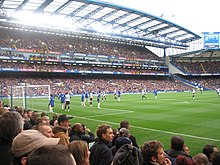
Chelsea fans at a match against Tottenham Hotspur, on 11 March 2006
During the 1970s and 1980s in particular, Chelsea supporters were associated with football hooliganism. The club's "football firm", originally known as the Chelsea Shed Boys, and subsequently as the Chelsea Headhunters, were nationally notorious for violent acts involving hooligans from other teams, such as West Ham United's Inter City Firm and Millwall's Bushwackers, before, during and after matches.[67] The increase of hooligan incidents in the 1980s led chairman Ken Bates to propose erecting an electric fence to deter them from invading the pitch, a proposal that the Greater London Council rejected.[68] Since the 1990s there has been a marked decline in crowd trouble at matches, as a result of stricter policing, CCTV in grounds and the advent of all-seater stadia.[69] In 2007, the club launched the 'Back to the Shed' campaign to improve the atmosphere at home matches, with notable success. According to Home Office statistics, 126 Chelsea fans were arrested for football-related offences during the 2009–10 season, the third highest in the division, and 27 banning orders were issued, the fifth highest in the division.[70]
Rivalries
Main articles: West London derby, Arsenal F.C.–Chelsea F.C. rivalry, and Chelsea F.C.–Leeds United A.F.C. rivalry
Chelsea do not have a traditional rivalry on the scale of the Merseyside derby or the North London derby because their West London derbies with Fulham or Queens Park Rangers
have not been as prominent over the years since the clubs have often
been in different divisions. A 2004 survey by Planetfootball.com found
that Chelsea fans consider their main rivalries to be with (in order):
Arsenal, Tottenham Hotspur and Manchester United.[71] Their rivalry with Tottenham Hotspur is said to have developed following the 1967 FA Cup Final, the first cup final held between two London clubs. Additionally, a strong rivalry with Leeds United dates back to several heated and controversial matches in the 1960s and 1970s, particularly the 1970 FA Cup Final.[72] More recently a rivalry with Liverpool has grown following repeated clashes in cup competitions.[73]Records
For more details on this topic, see List of Chelsea F.C. records and statistics.

Of Chelsea's current players, Frank Lampard has made the most appearances and scored the most goals
Chelsea's biggest winning scoreline in a competitive match is 13–0, achieved against Jeunesse Hautcharage in the Cup Winners' Cup in 1971.[76] The club's biggest top-flight win was an 8–0 victory against Wigan Athletic in 2010.[77] Chelsea's biggest loss was an 8–1 reverse against Wolverhampton Wanderers in 1953.[78] Officially, Chelsea's highest home attendance is 82,905 for a First Division match against Arsenal on 12 October 1935. However, an estimated crowd of over 100,000 attended a friendly match against Soviet team Dynamo Moscow on 13 November 1945.[79][80] The modernisation of Stamford Bridge during the 1990s and the introduction of all-seater stands mean that neither record will be broken for the foreseeable future. The current legal capacity of Stamford Bridge is 41,837.[2]

Didier Drogba is Chelsea's highest scoring overseas player and holds the club record for goals in European football (34)
Chelsea, along with Arsenal, were the first club to play with shirt numbers, on 25 August 1928 in their match against Swansea Town.[88] They were the first English side to travel by aeroplane to a domestic away match, when they visited Newcastle United on 19 April 1957,[89] and the first First Division side to play a match on a Sunday, when they faced Stoke City on 27 January 1974. On 26 December 1999, Chelsea became the first British side to field an entirely foreign starting line-up (no British or Irish players) in a Premier League match against Southampton.[90] On 19 May 2007, they became the first team to win the FA Cup at the new Wembley Stadium, having also been the last to win it at the old Wembley.[91] At the end of the 2007–08 season, Chelsea became the highest ranked club under UEFA's five-year coefficient system, the first English club to do so in the 21st century.[92] On the final day of the 2009–10 season, Chelsea became the first team in Premier League history to score at least 100 goals in a single season.[27] In 2012, Chelsea became the first London based club to win the UEFA Champions League, after beating Bayern Munich in the final.[4][5]
Finances and ownership

Chelsea owner Roman Abramovich
Chelsea has been described as a global brand; a 2012 report by Brand Finance ranked Chelsea fifth and valued the club's brand value at US $398 million – an increase of 27% from the previous year, also valuing it at US $10 million more than the sixth best brand, London rivals Arsenal – and gave the brand a strength rating of AA (very strong).[97][98] In 2012, Forbes magazine ranked Chelsea was seventh in their list of the ten most valuable football clubs in the world, valuing the club's brand at £473 million ($761 million).[9][10] Chelsea are currently ranked sixth in the Deloitte Football Money League[99] with an annual commercial revenue of £225.6 million.[100] Chelsea are additionally funded by Abramovich via interest free soft loans channelled through his holding company Fordstam Limited. The loans stood at £709 million in December 2009, when they were all converted to equity by Abramovich, leaving the club itself debt free,[101][102] although the debt remains with Fordstam.[103] Since 2008 the club has had no external debt.[104]
Chelsea's kit has been manufactured by Adidas since 2006, which is contracted to supply the club's kit from 2006 to 2018. The partnership was extended in October 2010 in a deal worth £160 million over eight years.[105] Previously, the kit was manufactured by Umbro (1968–81), Le Coq Sportif (1981–86), The Chelsea Collection (1986–87) and Umbro again (1987–2006). Chelsea's first shirt sponsor was Gulf Air, agreed during the 1983–84 season. The club were then sponsored by Grange Farms, Bai Lin Tea and Simod before a long-term deal was signed with Commodore International in 1989; Amiga, an off-shoot of Commodore, also appeared on the shirts. Chelsea were subsequently sponsored by Coors beer (1995–97), Autoglass (1997–2001) and Emirates Airline (2001–05). Chelsea's current shirt sponsor is Samsung[106] who took over the sponsorship from their mobile division in 2007–08. The club also has a variety of other sponsors and partners, which include Delta Air Lines,[107] Sauber, Audi, Gazprom,[108] Singha, Thomas Cook Sport, BNI, 188BET, EA Sports, Coca Cola, Dolce & Gabbana, Lucozade Sport and Viagogo.[109]
Popular culture
Up until the 1950s, the club had a long-running association with the music halls, with their underachievement often providing material for comedians such as George Robey.[116] It culminated in comedian Norman Long's release of a comic song in 1933, ironically titled "On the Day That Chelsea Went and Won the Cup", the lyrics of which describe a series of bizarre and improbable occurrences on the hypothetical day when Chelsea finally won a trophy.[15] The song "Blue is the Colour" was released as a single in the build-up to the 1972 League Cup Final, with all members of Chelsea's first team squad singing; it reached number five in the UK Singles Chart.[117] (The song was later adopted, as an anthem, by the Vancouver Whitecaps in Canada, after being changed to "White is the Colour".[118]) In the build-up to the 1997 FA Cup Final, the song "Blue Day", performed by Suggs and members of the Chelsea squad, reached number 22 in the UK charts.[119] Bryan Adams, a fan of Chelsea,[120] dedicated the song "We're Gonna Win" from the album 18 Til I Die to the club.[121]
Chelsea Ladies
For more details on this topic, see Chelsea L.F.C..
Chelsea also operate a women's football team, Chelsea Ladies. It has been affiliated to the men's team since 2004,[122] and is part of the club's Community Development programme. They play their home games at Imperial Fields, the home ground of Isthmian League club Tooting & Mitcham United.[123] The club won the Surrey County Cup in 2003, 2004, 2006, 2007, 2008, 2009 and 2010,[124] and were promoted to the Premier Division for the first time in 2005 as Southern Division champions. In the 2009–10
season, they finished 3rd in the Premier League, equalling their
highest ever placing, and in 2010 were one of the eight founder members
of the FA Women's Super League.[125] John Terry, the current captain of the Chelsea men's team, is President of Chelsea LFC.[126]







Tidak ada komentar:
Posting Komentar